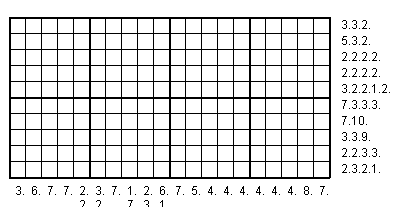Nonograms are logic puzzles that involve filling in cells in a grid to reveal a hidden picture. The grid is usually rectangular and comprises cells that can be filled in or left blank. At the beginning of the puzzle, some cells are already filled in, forming a pattern of shaded blocks.
How are Nonograms Played?
The objective of a nonogram is to use the clues provided on the edges of the grid to determine which cells should be filled in and which should be left blank, ultimately revealing a coherent image. Each clue consists of a sequence of numbers representing the lengths of consecutive filled cells in that row or column. The numbers are listed in the order they appear and are separated by at least one blank cell.
Solving a nonogram requires careful deduction and logical reasoning. By analyzing the clues and the intersections between rows and columns, players can gradually determine which cells should be filled and which should be left blank. The process often involves making educated guesses and using the process of elimination until the correct picture emerges.
Nonograms can vary in size and difficulty, ranging from small grids that can be completed quickly to larger and more complex puzzles that require more time and effort to solve. They are popular as mind teasers and can be found in puzzle books, newspapers, and online platforms.
Playing nonograms offers several benefits for individuals. Here are some of the potential advantages:
Improve thinking abilities: Nonograms require logical thinking, pattern recognition, and deduction skills to solve them. Regularly solving nonograms can help improve thinking abilities such as problem-solving, concentration, and analytical thinking.
Memory enhancement: Nonograms often involve remembering and applying previously deduced information. Filling in cells and keeping track of patterns can enhance short-term memory and strengthen memory recall abilities.
Relaxation and stress relief: Engaging in nonogram puzzles can have a calming effect on you. The focused nature of the activity can provide a sense of relaxation and serve as a stress-relieving pastime. It can be an enjoyable and meditative experience, allowing individuals to unwind and break from daily pressures.
Visual perception improvement: Nonograms require visual analysis and the ability to interpret visual clues. Regular practice with nonograms can enhance visual perception skills, including pattern recognition, spatial reasoning, and the ability to differentiate between shades and colors.
Patience and persistence: Nonograms, especially the more complex ones, can be challenging. They teach patience and persistence as players work through the puzzle, making gradual progress and not giving up easily. Developing perseverance can positively affect problem-solving abilities in other areas of life.
Entertainment and recreation: Solving nonograms can be an enjoyable and entertaining activity. It offers a sense of accomplishment and satisfaction when successfully completing a puzzle. Nonograms can be enjoyed individually or in a social setting, where friends or family members can solve puzzles together or compete for the best solving times.
Accessibility: Nonograms can be played in various formats, including physical puzzle books, newspapers, and digital platforms. They are easily accessible and can be enjoyed anywhere, anytime, providing convenient and portable entertainment.
Finally, it’s important to note that while playing nonograms can offer these benefits, moderation, and balance are key. Like any activity, it’s advisable to take breaks, maintain a healthy screen time routine, and engage in various physical activities for overall well-being.











